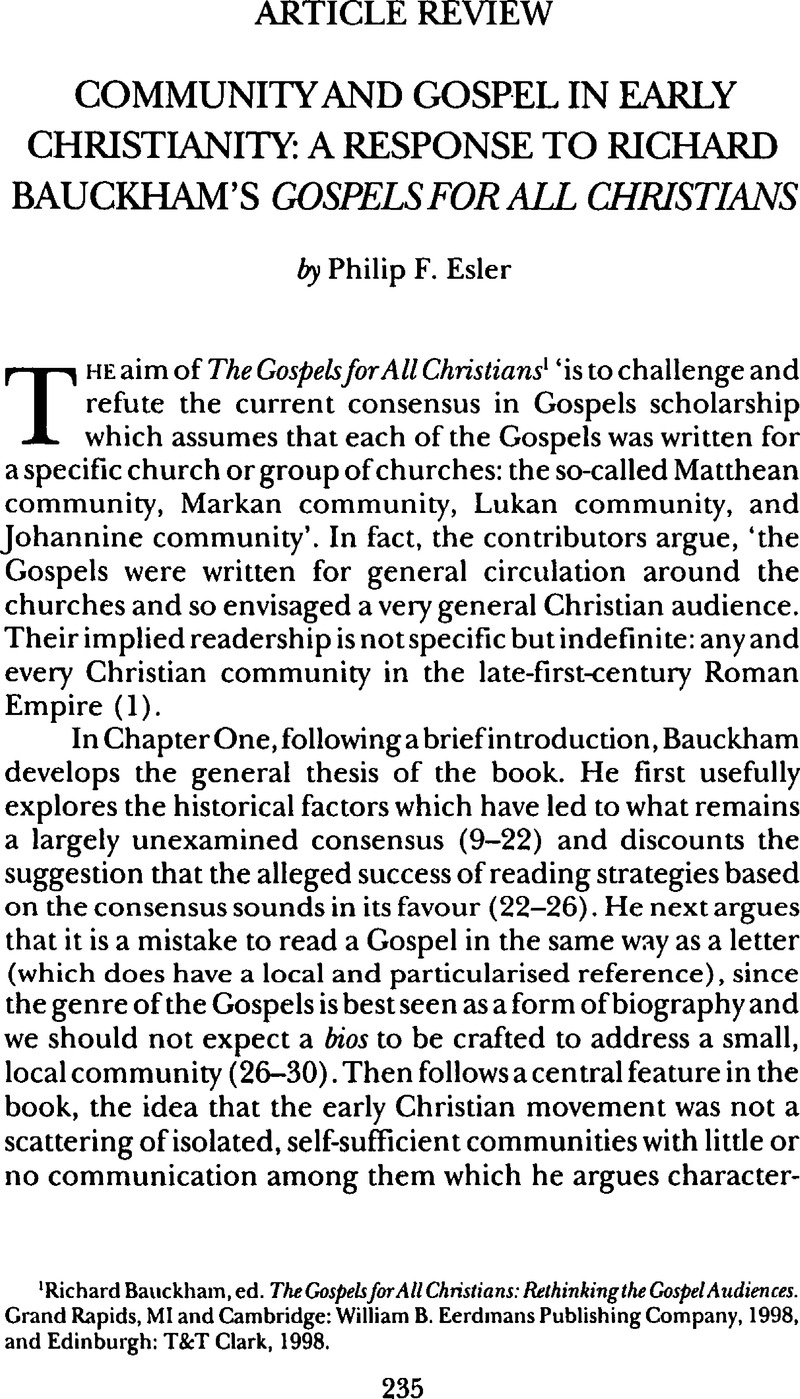Article contents
Community and Gospel in Early Christianity: A Response to Richard Bauckham's Gospels for all Christians
Published online by Cambridge University Press: 30 January 2009
Abstract

- Type
- Article Review
- Information
- Copyright
- Copyright © Scottish Journal of Theology Ltd 1998
References
1 Bauckham, Richard, ed. The Gospels for All Christians: Rethinking the Gospel Audiences. Grand Rapids, MI and Cambridge: William B. Eerdmans Publishing Company, 1998, and Edinburgh: T&T Clark, 1998.Google Scholar
2 Yet he only illustrates this charge with respect to one work (31), Overman's, AndrewMatthew's Gospel and Formative Judaism: The Social World of the Matthean Community (Minneapolis: Fortress Press, 1990).Google Scholar
3 See his article ‘The Beloved Disciple as Ideal Author’, (1993) JSNT Volume 49, 21–44, at 30, where he describes as ‘gratuitous’ and ‘highly questionable’ the assumption that the Fourth Gospel was ‘primarily intended for churches beyond the circle of thejohannine churches’.
4 Note, for example, her wariness about following Bauckham too far in assuming that the transition from oral transition to written text signals a movement from a local audience to a general one (100) and her suggestion that Johannine material circulated primarily among Johannine networks even if it did have the potential for interaction with adjacent networks (104), or even her plea for what looks very much like the consensus view for Luke (105).
5 The best starting point (not mentioned by Bauckham and company) remains Malina, Bruce J., The New Testament World: Insights from Cultural Anthropology. Revised edition. Louisville, KY: Westminster/John Knox, 1993.Google Scholar
6 Thus, while Barton is right to insist (with Edinburgh anthropologist Anthony Cohen) that ‘community’ is a word requiring careful definition since it is capable of carrying a heavy load of theoretical presuppositions (174–175), this is true of all our major terms, which require social-scientific modelling in view of the cultural distance between us and the New Testament texts, yet such a project is not undertaken by the contributors to this book.
7 See Hofstede, Geert, Culture's Consequences: International Differences in Work-Related Values. Beverley Hills, CA: Sage Publications, 1984.Google Scholar
8 Parker, D. C., Codex Bezae: An Early Christian Manuscript and Its Text. Cambridge: Cambridge University Press, 1992.CrossRefGoogle Scholar
9 Esler, Philip. F., Community and Gospel in Luke-Acts: The Social and Political Motivations of Lucan Theology (Cambridge: Cambridge University Press, 1987), 164–200.CrossRefGoogle Scholar
10 But that the notion of friendly relations (characteristic of our modern era) is probably more congenial to him can be seen in his views on how John and Mark are related (see below).
11 See the discussion in Esler, Community and Gospel in Luke-Acts, 89–93.
12 Oddly enough, the Gospel records at 4.2 (a later gloss?) that it was not Jesus but his disciples who did the baptising, yet even this would constitute a public ministry contemporaneous with that of John the Baptist unique to the Fourth Gospel.
13 Bauckham, ‘The Beloved Disciple’, 30.
14 Esler, Philip F., The First Christians in Their Social Worlds: Social-Scientific Approaches to New Testament Interpretation. London and New York: Routledge, 70–91.Google Scholar
15 Marxsen, Willi, Mark the Evangelist: Studies on the Redaction History of the Gospel (Nashville: Abingdon, 1969).Google Scholar
- 4
- Cited by


